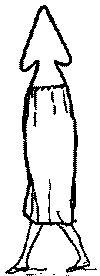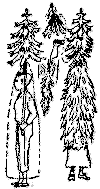By Dan Beard
HOW TO HAVE A HOLIDAY PARADE

The Christmas Parade
Away back in the Dark Ages the thoughtless people were accustomed to have all sorts of extravagant masquerade parades at Christmas time. Later, the wild pranks of the older people degenerated into begging schemes of the little folks, and in the last few years the children have transferred the ancient Christmas mummeries to Hallowe'en or Thanksgiving Day. This must be a foreign innovation, for no self-respecting American boy would think of parading the streets dressed up like a ragamuffin and begging a cent from each passer-by. The ragamuffin part is not so objectionable as is the asking of alms, so the Boy Pioneers and Sons of Daniel Boone must do their part to make these mummeries respectable; for mummeries in themselves are not at all un-American, and may be the cause of a lot of innocent fun.
When "we boys" do a thing we must do it up brown. So when we have a parade on one of these holidays our characters and costumes must have a meaning. The symbol of Audubon is a bird, so why not let Audubon dress as a bird ? He can do this by himself, but much better if he enlists the aid of his mother, big sister, or aunt to do the sewing for him. A bird must have wings, and a framework for the wings can be made of rattan, some old wooden barrel hoops, or any other substance which is supple enough to be bent and bound in the form shown in Figs. 389 and 389Y. A piece of barrel hoop (C J B, Fig. 389) is bent into the form of a bow. This is done by lashing a longer piece to one end at C, bending it around and lashing it again at B, then making a short loop to J on the first bow, where it is lashed

The Framework of the Wing and Tail
fast, as shown in the diagram. If the part C X B does not hold its position, as shown in the diagram, a spreader must be run across from A and made fast to both pieces. Fig. 389Y shows a front view of the boy with the framework of the wings attached to the hands and shoulders.

How to put on the bird skin.
A piece of tape is fixed like a yoke across his breast, and the loops under the arms are then tied to the tops of the wings over the shoulders. Loops made of a piece of leather strap, twine, or tape are fastened to the wing frames at X, and through these loops Audubon thrusts his hands. This will allow the wings to be raised and lowered like those of a real bird. The framework can be made by the boys themselves, but the covering of paper muslin or other cheap material will be best sewed on by some girl or lady friend. However, a real pioneer and backwoodsman, like a real sailor, should be able to do his own sewing. The wings should be covered on both sides, and then painted with a few lines to represent feathers, as in Fig. 392A.
Besides wings, all well-regulated birds are supposed to have tails. Fig. 390 shows how the tail is made. A piece of paper muslin is cut so that when it is folded at Z E and sewed together at Y D and D E it makes a flat bag. The bent stick (D E, Fig. 390) is then put in the tail for a stiffener and a spreader, as is shown in the diagram. The sketch of the boy (Fig. 390) shows how the tail is attached to the boy. But the tail bag must be sewed to the body of the

Fig. 392.
Showing How to Make the Head
bird-the hoop in front makes the bird's breast-as in Fig. 391. The body of the bird is simply a loose bag with holes cut into it for the arms and legs of the boy. A pucker string is put around each leg hole, and also the neck of the bag, so that it may be drawn up snugly and tied in place at these points, as is shown by the boy in Fig. 391. Make the beak of the bird of a piece of card-board by rolling it in funnel shape, as in Fig. 392.

Fig. 393
Make the framework of the head of the bird out of pieces of barrel hoop or other suitable material. Make first a hoop (F H K J) large enough in diameter to slip easily over the head and rest on the shoulders of the boy who is wearing it. Make another hoop (L K) to which the beak may be sewed or laced. Now, from F, at the back of the head, run an elastic stick through the hoop (K L) and allow the end (G) to extend into the beak. Support this stick (F G) by another hoop (H J) and let this be covered by a cloth hood with two big eyes painted on it, as shown in Figs. 391 and 392A.
Now, then, get into the bag, as in Fig. 391, put on the shoulder yoke, and attach the wings, as in Fig. 389. Slip the hood over your head and shoulders, and you will then look like Fig. 392A

Fig. 394.
Kit Car son's Costume

Fig. 395.
Johnny Appleseed's Costume
and be ready for the parade-the first live killaloo bird ever seen by man. Fig. 393 shows a large pasteboard arrow-head nailed to two cross sticks. A duplicate piece of pasteboard should be fastened over the sticks so as to conceal them. A piece of cloth is then stitched to the bottom of the arrow-head (Fig. 394).
Johnny Appleseed can tie a small Christmas tree to one end of a broomstick. Under the branches fasten a piece of green cloth on which evergreen twigs can be stitched. The bottom row of twigs should be sewed around the bag first, then the next row, like the shingles of a house.
When Johnny Appleseed gets under the bag and grasps the broomstick he will be the first walking tree seen in this or any other country. In a similar manner each officer of the society can transform his insignia of office into a costume and each pioneer can carry a log cabin or stockade on the end of a pole arranged in the same manner. The paraders may carry banners or transparencies with mottoes upon them such as: "Protect the Birds," " Save the Trees," " Preserve American Traditions" or "Canadian Traditions," as the case may be.
Of course, we must not forget Santa Claus in our procession, but we must remember that the American Santa Claus is as distinctive a character as Daniel Boone. He is the one described in the verses of "The Night Before Christmas." He is a fat little gnome, and as jolly as he is fat.
Place a pillow inside the coat for a paunch, make a beard of white cotton, and have fur or cotton-batting trimmings for coat and tops of boots. He must occupy a position on the Yule-log in the parade.
After the parade, build the Christmas fire with the Yule-log, or a bunch of Christmas firewood, and that will be an appropriate camp-fire for this jolly time of year.
When you break camp, give the Boone cheer, and end it with "A merry Christmas to all, and to all good-night."
Mummeries of this kind will not only be lots of fun, but they will also do great good by attracting the attention of people to the objects and aim of The Boy Pioneers. And if you can make them fit in with some worthy charity for Christmas, all the better.
